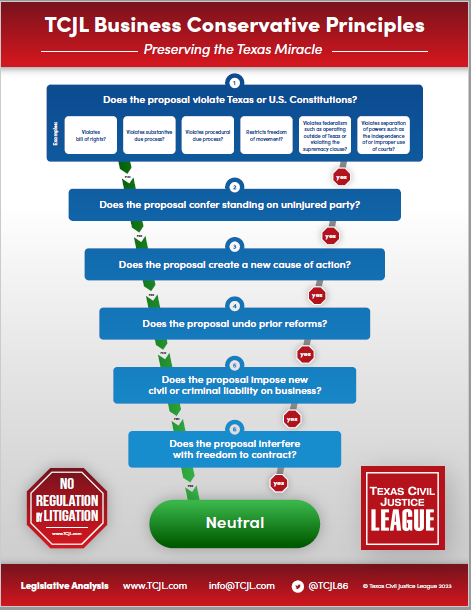 The House/Senate Joint Committee on Liability Insurance and Tort Law Procedure’s final report to the Legislature in January 1987 identified “high court activism” as one of the primary drivers of the tort liability crisis of that unfortunate era for the Texas civil justice system. Introducing its discussion of the watershed Texas Supreme Court opinions that “broke the bank” in terms of damages awards, the report quoted Justice Oliver Wendell Holmes for the proposition that “[t]he tendency of the law must always be to narrow the field of uncertainty.” The report then went on to detail 10 cases it found widened the field of uncertainty. Some of these decisions, as well as others not specifically identified by the Committee, dramatically liberalized the law of noneconomic damages, which we believe has produced the urgent need for a “fourth round” of reform, following the Legislature’s broad interventions in tort law in 1987, 1995, and 2003.
The House/Senate Joint Committee on Liability Insurance and Tort Law Procedure’s final report to the Legislature in January 1987 identified “high court activism” as one of the primary drivers of the tort liability crisis of that unfortunate era for the Texas civil justice system. Introducing its discussion of the watershed Texas Supreme Court opinions that “broke the bank” in terms of damages awards, the report quoted Justice Oliver Wendell Holmes for the proposition that “[t]he tendency of the law must always be to narrow the field of uncertainty.” The report then went on to detail 10 cases it found widened the field of uncertainty. Some of these decisions, as well as others not specifically identified by the Committee, dramatically liberalized the law of noneconomic damages, which we believe has produced the urgent need for a “fourth round” of reform, following the Legislature’s broad interventions in tort law in 1987, 1995, and 2003.
These cases include the following:
- Sanchez v. Schindler, 651 S.W.2d 249 (Tex. 1983). Reversing the pecuniary loss rule, the supreme court held that in a statutory wrongful death action the plaintiff may recover for loss of companionship and society and damages for mental anguish for the death of a minor child. The opinion explicitly stated that the responsibility for overturning more than a century of Texas law “did not belong to the Texas legislature,” but rather to the court. This attitude pervades the 1980s case law. (We should note that the Legislature was in the act of revising the wrongful death statute to permit such recovery even as the court released its opinion.)
- Madisonville I.S.D. v. Kyle, 658 S.W.2d 149 (Tex. 1983). The supreme court expanded the elements of recoverable damage to include “loss of companionship and society” (separate from past and present “mental anguish”). As the report stated, “[i]n doing so, the court established that compensability of two separate types of noneconomic damage that are, in practical fact, intermingled. There is no obvious way to make a perfect and explicable distinction between the psychological pain of “mental anguish” and the pain of “loss of companionship and society.”
- Yowell v. Piper Aircraft, 703 S.W.2d 630 (Tex. 1986). The supreme court created a new category of damages for “loss of inheritance.”
- Moore v. Lillebo, 722 S.W.2d 683 (Tex. 1986). According to the report, [t]he supreme court allowed for the first time recovery mental anguish in a wrongful death case without requiring some sort of physical manifestation. Additionally, the court recognized both mental anguish and loss of companionship and society and as separate injuries for which damages can be recovered. The dissent, by Justice Franklin Spears and joined by Justice Raul Gonzalez, concluded: ‘With improper definitions, such as the majority’s, mental anguish and loss of society and companionship issues ask jurors the same question: how much emotional distress has the plaintiff suffered? Asked the same question twice, jurors will give the same answer—twice.’”
- Pope v. Moore, 711 S.W.2d 622 (Tex. 1986). In a per curiam opinion, the supreme court jettisoned the traditional rule that appellate courts should remit “excessive” damage awards based on their “sound judicial judgment and discretion in the ascertainment of what amount would be reasonable compensation for the injury sustained. Wilson v. Freeman, 185 S.W. 993, 994 (Tex. 1916), quoted in Flanigan v. Carswell, 324 S.W.2d 835 (Tex. 1959). Concomitant with remittitur based on “reasonableness” was the requirement that a “court must first determine what amount would be reasonable, before it can determine what amount would be unreasonable.” & New Orleans R.R. v. Syfan, 44 S.W. 1064, 1066 (Tex. 1898). (It should be noted that in Syfan, the court dismissed the argument that exercising such power would violate the constitution. Syfan, 44 S.W. at 1066-67). The Pope court replaced this principled jurisprudence of excessiveness review with the significantly weaker standard for factual sufficiency review.
In our view, these cases weakened both the evidentiary requirements to establish the existence and amount of noneconomic damages and the authority of appellate courts to assure that such awards are reasonable. Taken together, the decisions: (1) opened the door to the creation of new types of noneconomic damages that are in reality “mental anguish” under different names; (2) eliminated the “physical manifestation” requirement, which in turn eliminated at least one “objective” measure by which mental anguish might be evaluated; (3) established a presumption without supporting evidence (which can’t be effectively rebutted) that noneconomic damages exist in cases involving injuries to certain family members); and (4) eviscerated appellate review of excessive awards.
For purposes of discussing the potential parameters of reform legislation in this area, we would suggest a statutory scheme providing that:
- a single type of noneconomic damages, e.g., mental anguish or pain and suffering, replace the current proliferation of derivative forms of the same thing;
- a party seeking noneconomic damages must specifically plead the amount of damages sought;
- entitlement to noneconomic damages must be proved regardless of the family or other personal relationships of the plaintiff(s);
- a claimant seeking mental anguish damages is deemed to have placed his or her mental health condition at issue and must produce pertinent records and results of mental health treatment;
- proof of noneconomic damages in a survival action must include objective evidence of a physical manifestation (i.e., the existence and treatment of specific health conditions associated with the alleged mental anguish);
- the existence and amount of noneconomic damages may only be proved by expert testimony based on scientifically valid and verifiable information;
- the existence and amount of noneconomic damages must be proved by clear and convincing evidence;
- the amount of noneconomic damages must be reasonably related to the amount of actual damages;
- “unsubstantiated anchoring,” including any reference to irrelevant standards of value (e.g., works of art, private aircraft, etc.) or discussion of the defendant’s net worth or economic position, or other jury argument expressing directly or indirectly that awarding noneconomic damages would “punish” or “send a message to” a defendant is presumptively harmful and reversible error and require a new trial;
- the supreme court shall promulgate a mandatory jury charge for the submission of noneconomic damages that defines appropriate terms, directs the jury to identify the specific evidence supporting an award, and emphasizing that an award is compensatory and bears no relation to the defendant or the nature of the defendant’s conduct (we would prefer the court undertook this task without referral to the relevant Pattern Jury Charge committees, but in the event the court desires to refer for “committee” consideration, it must appoint a special committee evenly divided between the plaintiff’s and defense bar);
- such jury instructions must specifically request the jury to make findings of fact pertinent to the “nature, duration, and severity” of the alleged injuries;
- when rendering a judgment that includes an award of noneconomic damages, the trial court must include a list of the specific grounds upon which the judgment is based and the specific items of evidence that support the judgment;
- de novo appellate review on a reasonableness standard (not factual insufficiency) with remittitur of excessive awards;
- appellate review must include a comparative survey of other noneconomic damages awards and, if the court affirms an award that is more than two times the amount of actual damages in the judgment or exceeds the average of noneconomic damages awarded in comparable cases, the court must state the specific reasons for affirming a judgment exceeding that amount;
- trial courts must report, within thirty days of the date the judgment becomes final, any judgment awarding noneconomic damages to the Office of Court Administration (OCA), including the amount of the damages and the trial court’s specific findings supporting the award;
- the OCA shall prepare, publish, and annually update a public report compiling all such judgments reported by the trial courts, which shall include a comparative analysis of those awards and any trends the OCA may detect in the frequency and amount of such awards; and
- the supreme court shall appoint a standing committee charged with conducting an ongoing review of noneconomic damages awards and making recommendations to the court for rulemaking or other measures, in Justice Holmes’s words, “to narrow the field of uncertainty.”
These are just some ideas at a preliminary stage in the process, and we will work to refine them in the coming months with an eye towards proposing legislation next spring.








